Rosemary oil (Tunisian) - growth and production
Essential Oils Production & Conservation/
23.02.24
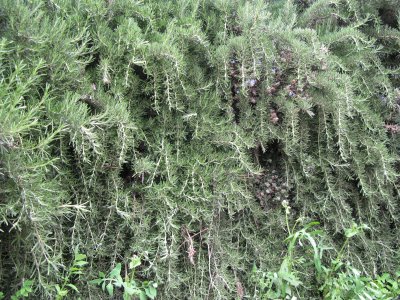
ROSEMARY OIL
(Tunisian)
Its growth and production
By Martin Watt
Its growth and production
By Martin Watt
In 1995 I was part of an aromatherapy tour visiting Tunisia organised by Clive
Bendon of Quality Analysis Ltd. UK. qal.uk.com The prime objective was to see
the rosemary oil being produced, although we also hoped to see Neroli
production.
Rosemary grows wild in Tunisia and many of the hillsare covered with the bushes - see image below.
All photographs © 1995 copyright M. Watt.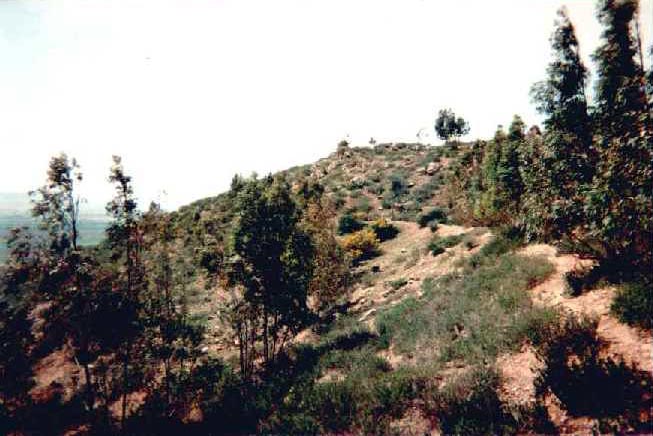
The bushes are wild and not subjected to fertilisers and pesticides. However, if
the plants were originally planted on these hills only a historian of French
colonial agriculture would know. My suspicion is they were planted - maybe a
hundred years or more ago - because there are many pieces of old clay pots
lying around. We should remember that the French fragrance industry
exploited most of their colonies for fragrance materials.¨)
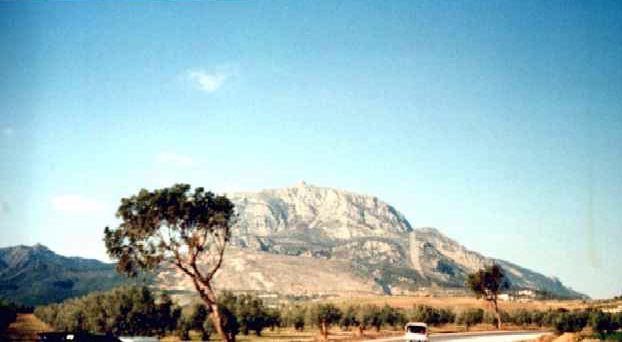
The area we headed to was about 70 miles inland from the Mediterranean
coast close to the village of Medjeb el bab. Here lies a large plain covered with
various crops. In the distance can be seen the low hills where the rosemary
grows. As you approach the hills you can see the green shimmer of the
rosemary. In places you could see what looked like bare scars running across
the hills (see above). These scars were firebreaks, which in this hot dry climate
were badly needed. Just imagine a hill covered in aromatic plants such as
rosemary catching fire!
As we drove up the dirt roads in the foothills, you could see other plants dotted
between the rosemary. These were the occasional Myrtle bush, plus quick
growing Eucalyptus trees planted to stabilise the loose rocky soil and to
provide firewood.
The track wound its way up the hill and in so doing it divided the hill into
separate sectors. This meant that as the rosemary was harvested, there was
no need for the workers to scramble up the steep slopes. Instead they used
donkeys that could amble along the road until they reached the rosemary heap
near the still. The donkeys were loaded up with huge bundles of rosemary tied
up with sacking. Although the load looked huge, it was of course mostly air and
so not too heavy.
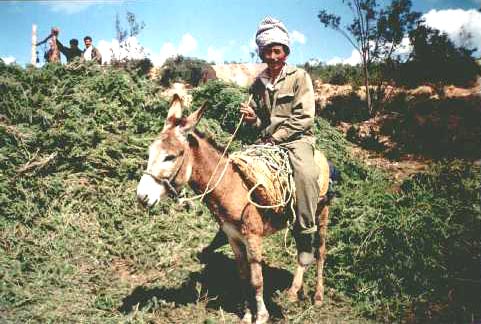
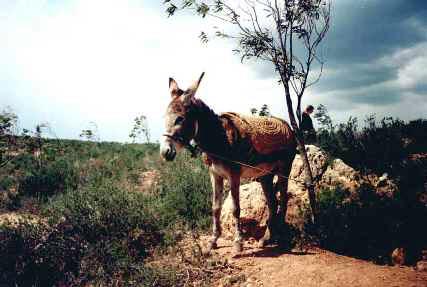
We were told that the rosemary could be harvested twice a year. One hillside
was harvested then the still was shifted to another one. By the time the other
areas had been harvested over a 3-month cycle, the original plants had
regrown and could be harvested again. Then the whole area was left alone
until the next year.
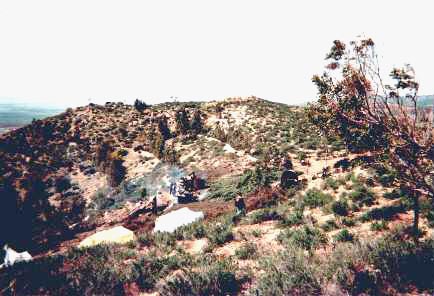
All harvesting was done by hand by the men from the nearest local villages.
They camped out on the hillsides during the production season under simple
shelters made of a few wooden poles and plastic sheeting. There were no toilet
facilities other than a hole in the ground so you could say the plants were truly
organically grown! All their needs of food, water, etc. were bought up from the
village in pickup trucks.
The only things needed for producing the rosemary oil that were not available
on the hills was water and the stills themselves.
As can be seen from the photos, the stills are large thick walled steel drums
about 2 metres in diameter and about 1.5m high. A platform is made of soil
and rocks so that the still can be placed over the fire.
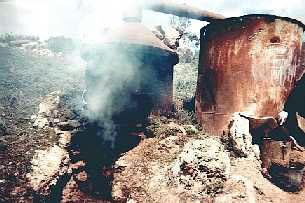
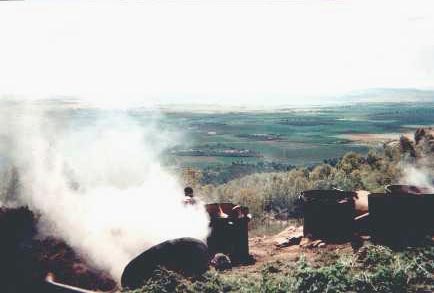
The primary still is filled with water and freshly cut rosemary. This process is
known as hydro distillation and is exactly the same as cooking your vegetables.
The fact the herb is immersed in water means the oil is not so chemically
degraded as can occur with hot steam distillation. The conical lid is then placed
over the still and is partly sealed with mud. The lid has a pipe that leads the
aromatic vapours rising from the rosemary into the cooling condenser next to
the primary still. The cooling condenser is filled with cold water with a coil
running though it which condenses the hot still vapours. At the base is the
receptacle in which the condensate of oil and water falls. Once there, as the
mixture cools, the oil floats to the top and is siphoned off into another
container. Finally, the oil is poured into barrels and taken to the storage areas
by truck.
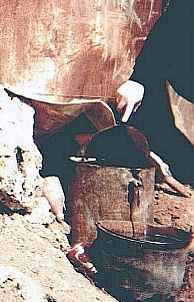
Once the rosemary charge has been exhausted, (that is a judgement made by
the foreman based on experience), it is forked out onto the hill and dries out in
the bright sun. It is this spent material that is used to fire the still (see below).
Therefore, the whole process can be considered as extremely 'environmentally
friendly' as only the water is taken to the site. Everything else comes from the
soil and the sun.
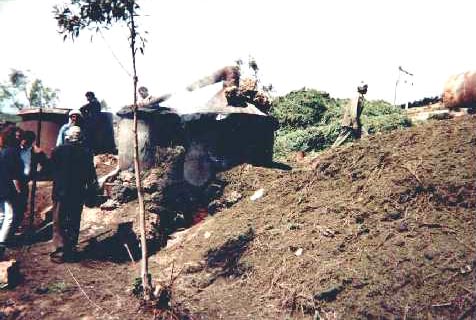
The smell coming from the still during the processing is divine. If only you
could bottle the air! With this kind of open-air distillation a lot of the highly
volatile gases that occur in the plant are lost to the atmosphere. The only way
such highly volatile compounds can be captured is to use cold processes such
as solvent extraction. However, often these natural compounds are so unstable
that they cannot be captured and preserved. The only way to experience them
is to grow the plants, or be present where they grow. Then on a hot day go
and breath the air, now that is TRUE aromatherapy.
Despite the loss of "top note" volatiles to the air, this Tunisian hydro distilled
rosemary is a top quality oil. Any hydro distilled rosemary oil will be far
superior to steam distilled oil. The way to tell a steam-distilled oil from hydro
distilled is quiet simple. If the oil smells more like eucalyptus the chances are it
is steam distilled. A good quality hydro distilled rosemary should smell almost
the same as the fresh herb. Turkish hydrodistilled rosemary has a similar
fragrance to the Tunisian oil.
Bendon of Quality Analysis Ltd. UK. qal.uk.com The prime objective was to see
the rosemary oil being produced, although we also hoped to see Neroli
production.
Rosemary grows wild in Tunisia and many of the hillsare covered with the bushes - see image below.
All photographs © 1995 copyright M. Watt.

The bushes are wild and not subjected to fertilisers and pesticides. However, if
the plants were originally planted on these hills only a historian of French
colonial agriculture would know. My suspicion is they were planted - maybe a
hundred years or more ago - because there are many pieces of old clay pots
lying around. We should remember that the French fragrance industry
exploited most of their colonies for fragrance materials.¨)

The area we headed to was about 70 miles inland from the Mediterranean
coast close to the village of Medjeb el bab. Here lies a large plain covered with
various crops. In the distance can be seen the low hills where the rosemary
grows. As you approach the hills you can see the green shimmer of the
rosemary. In places you could see what looked like bare scars running across
the hills (see above). These scars were firebreaks, which in this hot dry climate
were badly needed. Just imagine a hill covered in aromatic plants such as
rosemary catching fire!
As we drove up the dirt roads in the foothills, you could see other plants dotted
between the rosemary. These were the occasional Myrtle bush, plus quick
growing Eucalyptus trees planted to stabilise the loose rocky soil and to
provide firewood.
The track wound its way up the hill and in so doing it divided the hill into
separate sectors. This meant that as the rosemary was harvested, there was
no need for the workers to scramble up the steep slopes. Instead they used
donkeys that could amble along the road until they reached the rosemary heap
near the still. The donkeys were loaded up with huge bundles of rosemary tied
up with sacking. Although the load looked huge, it was of course mostly air and
so not too heavy.


We were told that the rosemary could be harvested twice a year. One hillside
was harvested then the still was shifted to another one. By the time the other
areas had been harvested over a 3-month cycle, the original plants had
regrown and could be harvested again. Then the whole area was left alone
until the next year.

All harvesting was done by hand by the men from the nearest local villages.
They camped out on the hillsides during the production season under simple
shelters made of a few wooden poles and plastic sheeting. There were no toilet
facilities other than a hole in the ground so you could say the plants were truly
organically grown! All their needs of food, water, etc. were bought up from the
village in pickup trucks.
The only things needed for producing the rosemary oil that were not available
on the hills was water and the stills themselves.
As can be seen from the photos, the stills are large thick walled steel drums
about 2 metres in diameter and about 1.5m high. A platform is made of soil
and rocks so that the still can be placed over the fire.


The primary still is filled with water and freshly cut rosemary. This process is
known as hydro distillation and is exactly the same as cooking your vegetables.
The fact the herb is immersed in water means the oil is not so chemically
degraded as can occur with hot steam distillation. The conical lid is then placed
over the still and is partly sealed with mud. The lid has a pipe that leads the
aromatic vapours rising from the rosemary into the cooling condenser next to
the primary still. The cooling condenser is filled with cold water with a coil
running though it which condenses the hot still vapours. At the base is the
receptacle in which the condensate of oil and water falls. Once there, as the
mixture cools, the oil floats to the top and is siphoned off into another
container. Finally, the oil is poured into barrels and taken to the storage areas
by truck.

Once the rosemary charge has been exhausted, (that is a judgement made by
the foreman based on experience), it is forked out onto the hill and dries out in
the bright sun. It is this spent material that is used to fire the still (see below).
Therefore, the whole process can be considered as extremely 'environmentally
friendly' as only the water is taken to the site. Everything else comes from the
soil and the sun.

The smell coming from the still during the processing is divine. If only you
could bottle the air! With this kind of open-air distillation a lot of the highly
volatile gases that occur in the plant are lost to the atmosphere. The only way
such highly volatile compounds can be captured is to use cold processes such
as solvent extraction. However, often these natural compounds are so unstable
that they cannot be captured and preserved. The only way to experience them
is to grow the plants, or be present where they grow. Then on a hot day go
and breath the air, now that is TRUE aromatherapy.
Despite the loss of "top note" volatiles to the air, this Tunisian hydro distilled
rosemary is a top quality oil. Any hydro distilled rosemary oil will be far
superior to steam distilled oil. The way to tell a steam-distilled oil from hydro
distilled is quiet simple. If the oil smells more like eucalyptus the chances are it
is steam distilled. A good quality hydro distilled rosemary should smell almost
the same as the fresh herb. Turkish hydrodistilled rosemary has a similar
fragrance to the Tunisian oil.
Source and copyright: aromamedical.org
319
More posts
